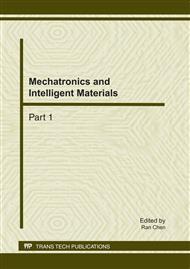p.871
p.876
p.881
p.886
p.891
p.895
p.900
p.904
p.909
Design of a Topology Nano-Positioning Stage
Abstract:
Nano-positioning technology has been widely used in many fields, such as microelectronics, optical engineering, and micro-technology equipment and manufacture. This paper presents a one-dimensional positioning system, adopting a PZT piezoelectric ceramic nano-positioning stage designed by multi-objective topological optimal synthesis. In order to obtain better performance, wedge-shaped structure has been applied as a precise pretension for the piezoelectric ceramic. Through finite element simulation and experimental verification, better static performance and smaller kinetic coupling are achieved, with up to 10 μm stroke displacement output and 5 nm resolution. This stage provides a novel, flexible, and efficient way in the design and optimization of the nano-positioning system.
Info:
Periodical:
Pages:
891-894
Citation:
Online since:
February 2011
Authors:
Price:
Сopyright:
© 2011 Trans Tech Publications Ltd. All Rights Reserved
Share:
Citation:


